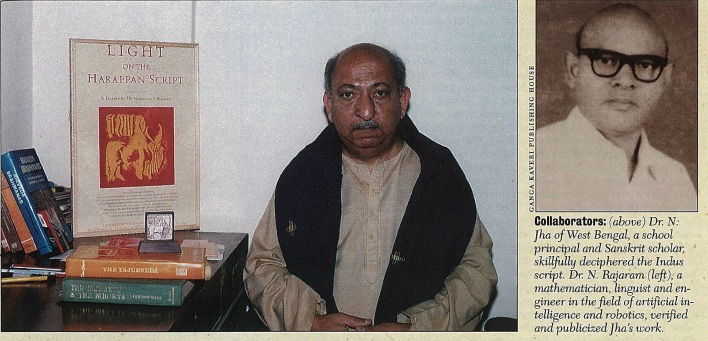I have worked with outstanding scientists at NASA, including Nobel laureates,” Dr. N.S. Rajaram told Hinduism Today. “Never have I met a genius like Dr. Natwar Jha. His command of language and ability to correlate details is astounding.” Jha’s prodigious abilities may well earn him a coveted place in history as the man who finally deciphered the confounding script of the Indus Valley civilization. The remains of that civilization were discovered by British explorers in 1875 in what is now Pakistan. Yet, much about the people who inhabited these urban centers remains in the dark because the script they used, specimens of which are available on 4,000 small soapstone seals, has long baffled scholars.
Natwar Jha, a 58-year-old Vedic scholar and paleographer from West Bengal, may have found the solution to the great problem. In a slim volume of 60 pages titled Vedic Glossary on Indus Seals, Jha has provided both the key to the ancient script as well as a large number of readings. After a careful examination of his work, the American Vedic scholar Vamadeva Shastri (David Frawley) and N.S. Rajaram, both experts in the Indus civilization, believe his reading to be substantially correct. By applying Jha’s methods they found they could independently read a large number of seals. The breakthrough was reported in the Indian press in November, 1997, but most scholars have yet to even hear of it, much less study Jha’s book.
Is it reasonable that an unknown scholar working in a rural part of West Bengal could make such a breakthrough? At least two of the great decipherments of history–Egyptian hieroglyphics and Minoan “Linear B” script–were cracked by outside amateurs. Thomas Young, a brilliant English doctor and physicist, deciphered hieroglyphics on the famed Rosetta Stone in 1815. The Linear B script was deciphered only in 1952 by the determined amateur Michael Ventris, a British architect. Outsiders, in fact, have a decided advantage over those logically more qualified for the work, for they do not share the prejudices and misconceptions which may have taken deep root among scholars.
The first and biggest misconception corrected by Jha concerned who inhabited the Indus Valley. Most scholars believe it was a Dravidian-speaking people who were driven out of the area in 1500 bce by an invasion of Aryans from the north and west. They therefore assumed the script to be an ancient form of a Dravidian language, perhaps Tamil. All attempts to provide a Dravidian interpretation for the script have failed. But in the last ten years, a strong minority of scholars and others have challenged the Aryan Invasion theory as wrong and proposed that the people of the Indus Valley are the ancestors of people who live in India today. Accepting this point of view, Jha proceeded on the assumption the seals were in an ancient form of Sanskrit.
Jha decided to search for Vedic words on the seals. In this he was helped by an ancient work known as the Nighantu. It is a glossary of Sanskrit words compiled by the sage Yaska. Jha also found that the “Shanti Parva” of the Mahabharata (the ancient history of India) preserves an account of Yaska’s search for older, “buried” glossaries–perhaps the seals–in compiling his own. From this Jha concluded that some of the seals must contain words found in Yaska’s Nighantu. This conclusion was critical, for it greatly narrowed what he was looking for. The Nighantu is a late Vedic work, dealing with the words of ancillary Vedic texts. The entire Rig Veda would already have been in existence for thousands of years at the time the seals were produced.
It has long been known that there was a correspondence between the Indus script and characters in other ancient scripts of the Indian sub-continent and neighboring regions. Especially it had been demonstrated that there was some relationship between the Indus script and the most ancient forms of Brahmi, the predecessor to the Sanskrit Devanagiri script. In an amazing feat of correlation, Jha compared all of the characters from all languages and produced a concordance of similar characters and sounds. He found that letters of most of the ancient scripts were related to Indus signs.
By painstaking cross-referencing, he slowly hit upon the meaning of individual symbols, and found words from the Nighantu on the seals. After several hundred seals, he arrived at a relatively consistent system of translation that anyone can apply. Now the job is to verify and refine his work.
TO CONTACT DR. N. JHA AND TO ORDER COPIES OF VEDIC GLOSSARY ON INDUS SEALS WRITE: GANGA KAVERI PUBLISHING HOUSE, D. 35/77, JANGAMAWADIMATH, VARANASI 221 001 INDIA. N.S. RAJARAM, F2 “RAJATHA MANOR,” 42 PETALAMMA TEMPLE ROAD, BASAVANAGUDI, BANGALORE 4, INDIA.


